13 Main Types of eCommerce Business Models
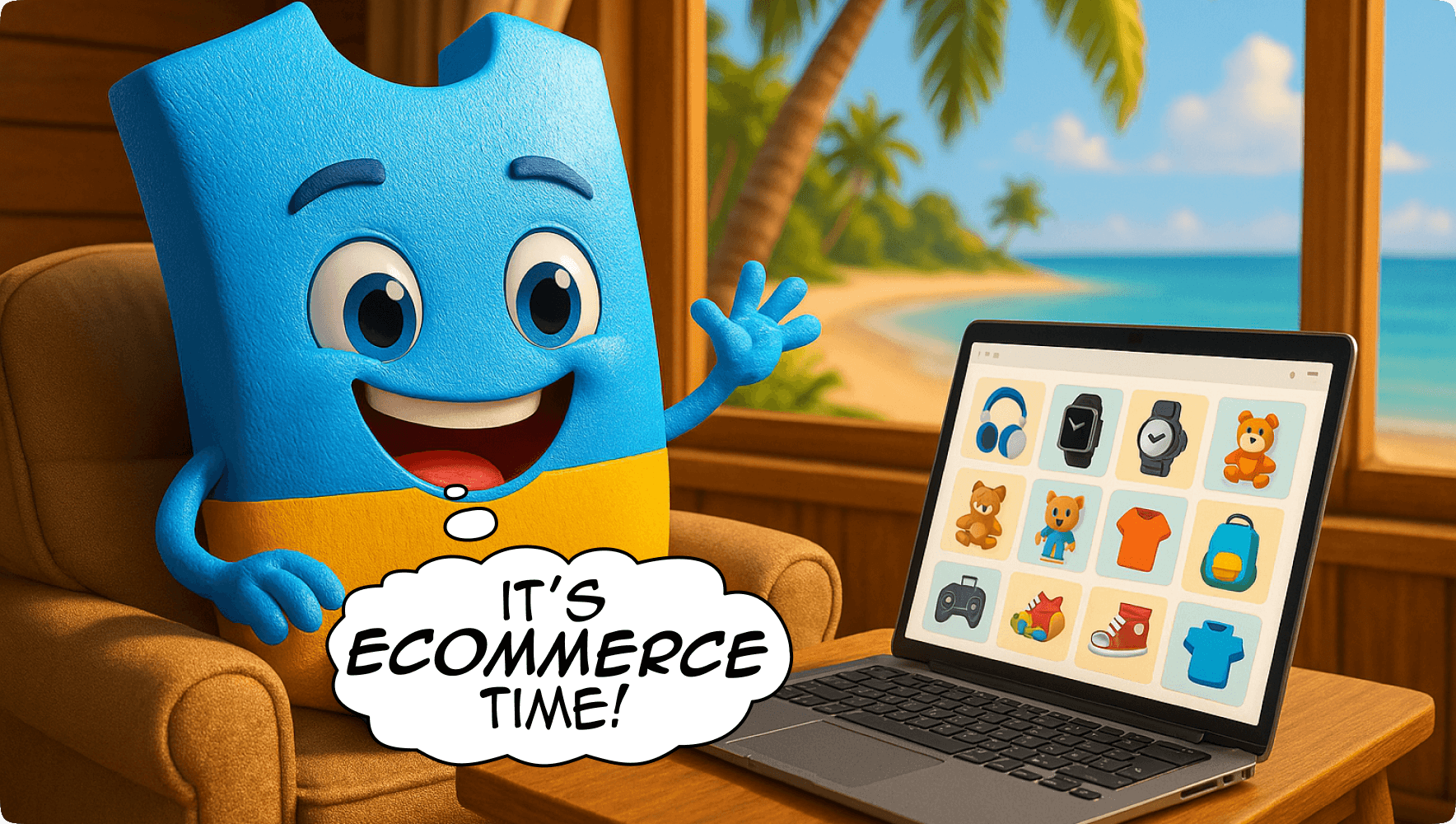
For the past 2 decades, eCommerce has been rapidly growing along with its share in global retail sales. It’s a great business model enabling individuals and businesses alike to purchase products and services at a convenient time from any point in the world provided there’s access to the Internet. This guide sheds light onto different types of e-commerce business models. It can help you pick the best model for your future venture or find a new way to market your products or services. Grab some coffee, there’s a lot to unpack:
- Short overview of e-commerce
- 13 types of eCommerce business models, how they work + examples
- How to empower your eCommerce business with marketing gamification
What is an eCommerce Business Model?
One of the most popular online business models, e-Commerce refers to selling products or services on the Internet. As a rule of thumb, entities (businesses and individuals) use online platforms that facilitate the selling process and money transactions.
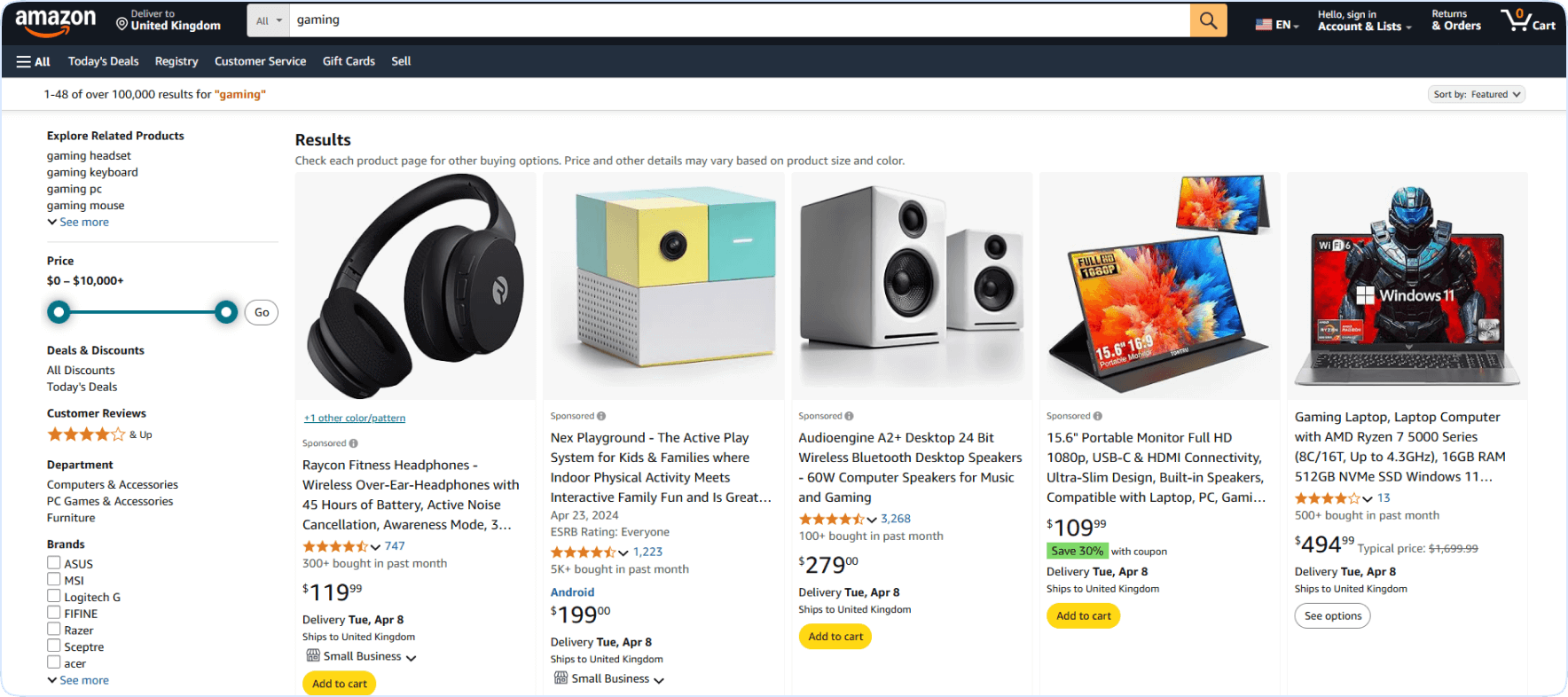
Amazon one of the most popular eCommerce platforms.
According to Statista, 17% of retail sales worldwide were done via e-commerce in 2024 and this number is projected to reach 21% by 2029. Another research showed that global e-commerce sales peaked in 2024 reaching $7 trillion globally, and will exceed $10.4T in 2028. Impressive, isn’t it? e-Commerce is a profitable business model once you understand how to do it right and which of its types best fits you and your product. The types are:
- Business-to-Consumer (B2C)
- Business-to-Business (B2B)
- Consumer-to-Consumer (C2C)
- Consumer-to-Business (C2B)
- Direct-to-Consumer (DTC)
- Subscription-based model
- Dropshipping
- White Label & Private Label
- Print-on-Demand (POD)
- Wholesale
- Marketplace
- Flash Sales & Group Buying
- Business-to-Consumer-to-Business (B2C2B)
Each model has its pros and cons. You need to have a clear understanding of what your product is, who your customers are, and what is the best way to sell products to them. Answering these questions will help you define your type of eCommerce and build your customer acquisition strategy accordingly.
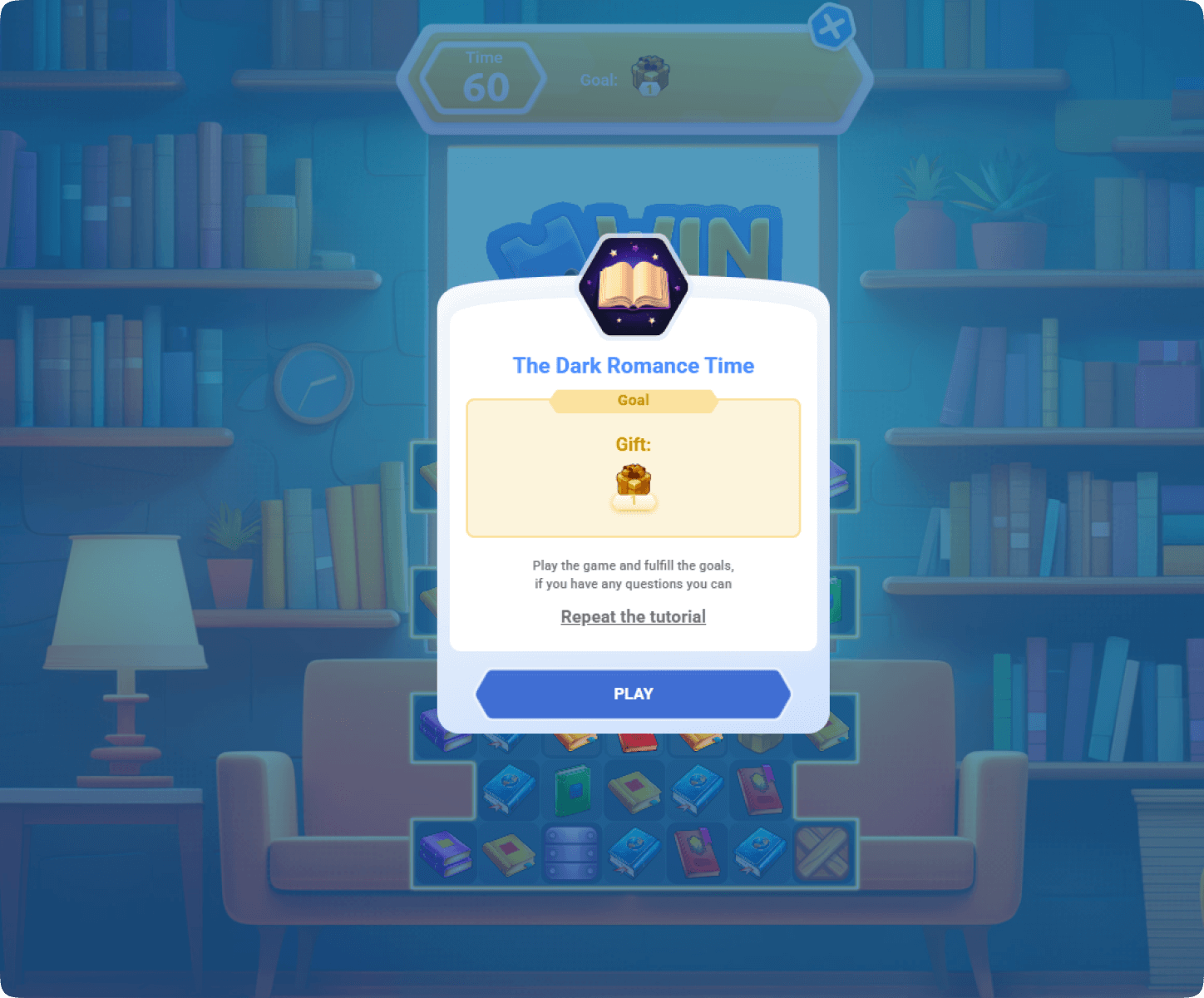
Gamification is a great way to attract new customers.
🔝 Pro Tip:
Whatever type of eCommerce business model you choose, you can increase your customer engagement, conversions and loyalty using Winday Marketing Gamification Platform. We’ll explain how to do it in great detail in this guide.
Main Types of Business Models in eCommerce
In this section of our guide, we discuss 13 types of e-commerce business models including the following information:
- Short overview of the model
- How it works
- Several real-life examples
- Key characteristics
- Ways to boost sales with online games
Keep in mind that many successful businesses do not focus on a single model expanding their operations and opportunities to earn income.
1. Business-to-Consumer (B2C) Business Model
One of the most wide-spread business models in eCommerce is the Business-to-Consumer model abbreviated as B2C (pronounced B to C).
Definition:
Similar to offline stores, companies operating within the B2C business model offer products or services to the end consumer. If you have ever bought groceries or ordered services online, you’ve engaged in B2C. Usually, products and services are simple and don’t require long considerations before the purchase.
How B2C Business Model Works:
- Large companies create websites and / or applications to sell products or services online. Usually these are large retail chains or service providers.
- SMBs and companies selling niche products usually use marketplaces to connect with their target audience as competing online against large retailers is hard.
- Companies often resell products that they bought elsewhere.
- When marketing products B2C companies use customer emotions like the desire to get a nice-looking new thing or fear of missing out on a new trend.
- Another emphasis is on the convenience of online shopping compared to the brick-and-mortar stores, especially if there’s an option to complete purchases on mobile devices.
- Purchasing decisions are usually made single-handedly, and sometimes by a group of people, usually a family. Decisions are quick and based on emotions or basic needs (like need to eat) in the first place. Although they do involve some rational thinking like comparing prices or evaluating the necessity of a purchase.
- Since people are “googling” products they have a sense of control over their choice, which is a powerful emotional boost to purchase.
- Finally, online shopping offers lower prices as businesses can cut costs on rent and employee salary that would inevitably occur with selling products in physical stores.
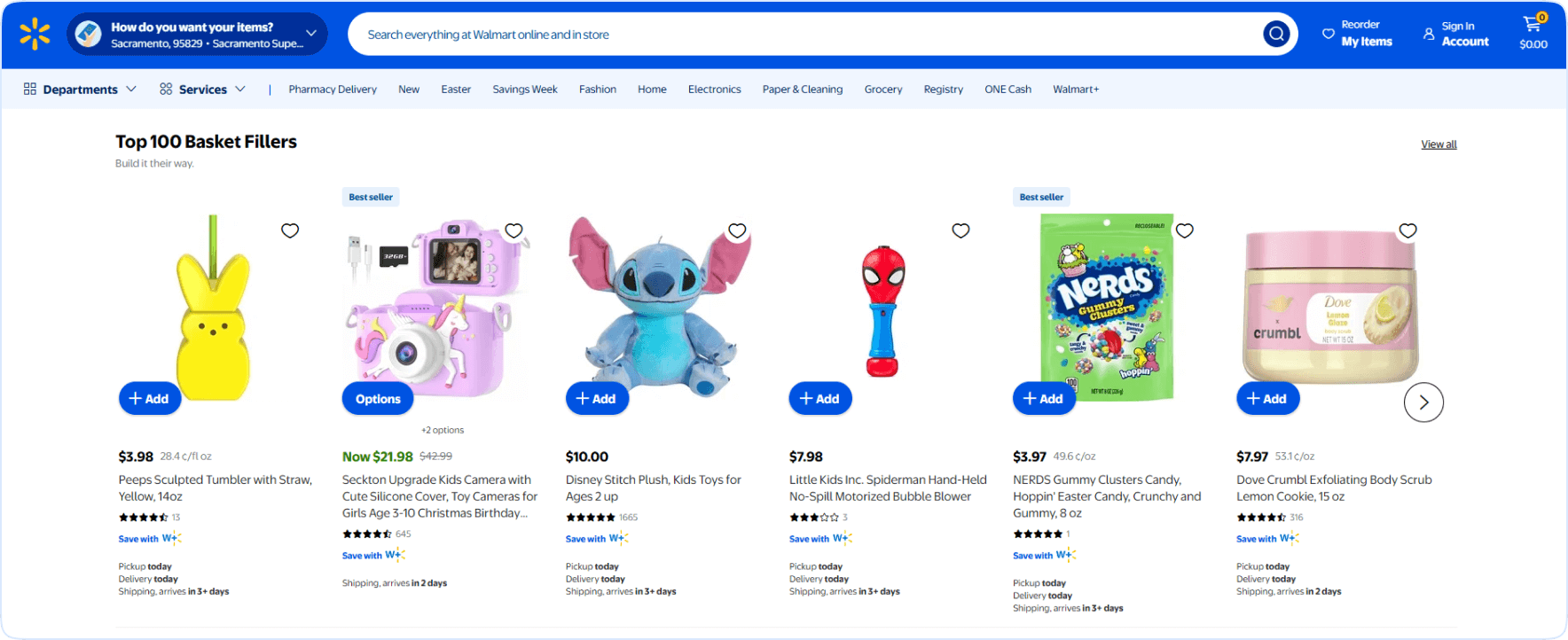
One of the popular B2C online shops, Walmart, offering its customer’s product to put in the upcoming Easter’s basket.
Examples of B2C eCommerce Business Model:
- Amazon is one of the largest B2C marketplaces that began as an online bookstore but grew into an e-Commerce giant. Today you can buy almost anything here. Recently Amazon began opening physical stores in the United States.
- Walmart has a history that’s reverse to Amazon. The company began as a brick-and-mortar retail store chain that saw an opportunity in e-Commerce, took it and succeeded. After the giant opened their online shop their shares have grown by 82% in 2024.
- Adored Vintage is an example of a small store that was created using Shopify platform to sell a niche product (vintage garments). Shopify listed them in their 50 best stores.
Key Characteristics of B2C eCommerce Business Model:
- e-Commerce retailers usually have a large total addressable market since they sell products for end users. That’s why they can enjoy a large customer base and high revenues.
- At the same time they heavily rely on technology as they need to operate online stores, including inventory management systems, marketing tools, shipping & logistics solutions, CRMs, etc.
- To succeed in B2C commerce, businesses need to invest a lot of resources in digital marketing: SEO to get to the top of the search, PPC to advertise their products and drive traffic, email marketing with special offers for customer retention, SMM to build community and communicate with customers, and content strategy to support these channels.
- One of the recent trends is omnichannel outreach, when a customer journey stretches through multiple channels (social media, email, SMS, website, etc.).
- If you want to succeed in eCommerce you also need to offer good pricing and fast delivery. In certain cases, it means that you need to be able to process the order 24/7.
Winday Usage:
One of the key challenges of B2C models is customer engagement that has been consistently declining over the past years. People are constantly distracted, and it leads to high cart abandonment rates. Customer loyalty is at an all-time low as in a saturated market of dozens of similar retailers, it’s very hard to stand out, especially if you do not offer niche products. That’s why finding new unconventional methods to engage with your customers and provide them with a memorable buying experience is critical. Winday gamification software offers retailers an opportunity to leave a long-lasting impression on their customers with online games.
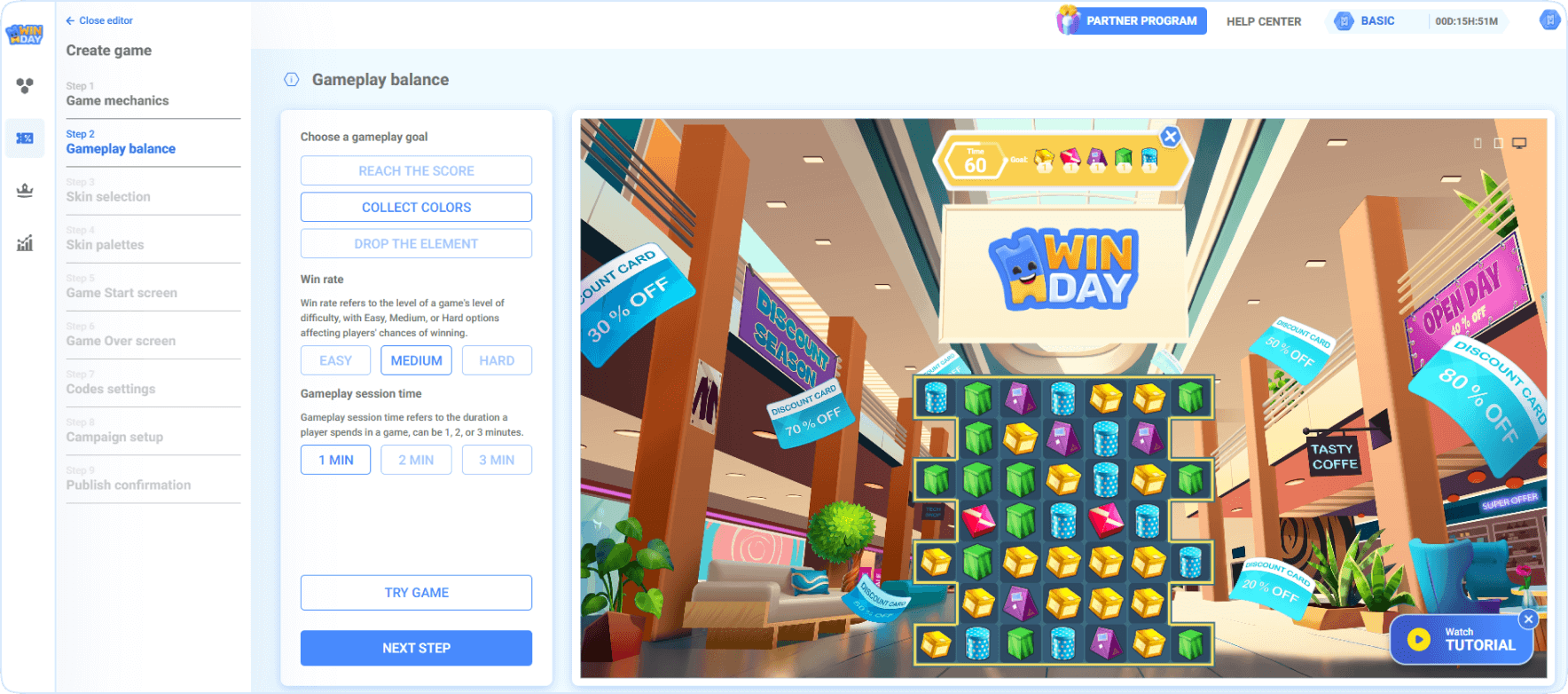
Simple Game creation process in Winday.
All you need to do is subscribe to Winday, create your first no-code Instant Game or Tournament Game in less than 30 minutes, install a plugin on your shop, and you’re good to go. Now, you can offer your customers to win discounts by playing your game. Once they’ve won a prize (e.g., a coupon codes), they’ll be more inclined to complete a purchase. And since playing is fun, they’ll remember your store and return for more.
2. Business-to-Business (B2B) Business Model
Business-to-Business or B2B is another example of popular e-Commerce business models. Let’s take a closer look at it.
Definition:
In the B2B business model, companies sell their products or services to other businesses. Have you ever been on your company’s buying team purchasing new equipment or ordering design of a corporate website? That’s B2B. Purchases in this model often involve bulk, however, a decision is often made by a group of employees as opposed to single-handed decisions in the B2C model. It’s also much more rational compared to B2C, and the buying process can last from several weeks to several years depending on the product.
How B2B Business Model Works:
- B2B companies are manufacturers, wholesalers, IT companies, and service providers who compete with other B2B companies over the contracts with businesses in need of their products or services.
- Purchases often but not necessarily include wholesale (i.e., selling multiple products of the same type).
- A contract might include recurring orders, and prices can be formed based on the contract size.
- Marketing requires creating a large body of content that educates about the product or service, explaining its benefits for the business, and how it can help business achieve goals and solve challenges. It’s less about emotions and more about the value.
- Companies find B2B businesses online and reach out via available channels usually, email or phone. Another way to connect is via B2B marketplaces.

Alibaba is one of the largest B2B marketplaces.
Examples of B2B eCommerce Business Model:
- Uline is a large supplier of industrial packaging and warehouse equipment. Headquartered in Wisconsin, they have regional offices all over North America. They also have a large website, where companies can order things online in bulk.
- Alibaba is an example of a B2B marketplace where manufacturers meet their clients. For buyers, it’s a great way to compare prices, negotiate deals and find new suppliers.
- Salesforce is a software company that sells an enterprise-level Customer Relations Management system to other businesses.
- Berry-Blue is a London-based company that offers corporate catering to local businesses. It’s a rare example of a B2B business that appeals to your emotions just as much as to your rational part.
Key Characteristics of the B2B eCommerce Business Model:
- Your total addressable market is much smaller compared to B2C. Thus, you will have fewer deals and fewer competitors.
- At the same time, the cost of a single purchase can be higher due to the price of the product / service (e.g. manufacturing equipment can cost hundreds of thousands of dollars) or due to the number of items within a single purchase (e.g., the building company purchases dozens of thousands of nails in one go).
- The products or services are usually complex and require salespeople to work with the buying group for an extended period of time to explain the benefits and negotiate the deal.
- At the same time, you can build long-lasting relations with your customer ensuring better retention rates compared to B2C and recurring purchases.
Marketing Gamification
In this model, marketing gamification is rarely used due to the impact of rational evaluation in the purchasing process. However, we saw a couple of examples like Salesforce’s Trailhead. Often it is used not for purchasing but for customer retention with games are a great way to learn new things. We suggest developing a custom game.

Some B2B companies choose zero-code game platforms to build marketing gamification experience for their outreach to customers. One of our clients installed a widget with a game created in Winday in their marketplace to attract new bulk buyers. Another client created an exclusive game tournament that was only available to their clients. They shared the link and the access code to the tournament via email. They used this tournament to offer special discounts to loyal customers for their overstock.
3. Consumer-to-Consumer (C2C) Business Model
One of the easier types of eCommerce businesses as it doesn’t require significant investments and is facilitated by the new technologies that can easily connect individuals with their customers.
Definition:
In the C2C eCommerce business model, individuals trade their products and services to end consumers directly. Have you ever sold a used item you don’t need anymore in a Facebook group? That’s C2C. It’s a great way to earn money for people who provide services like haircuts or artists selling their art to fans. There are many ways to find customers online. The easiest one is via online marketplaces and social media. Another possibility is building your own website, however, it usually only works for very niche products.
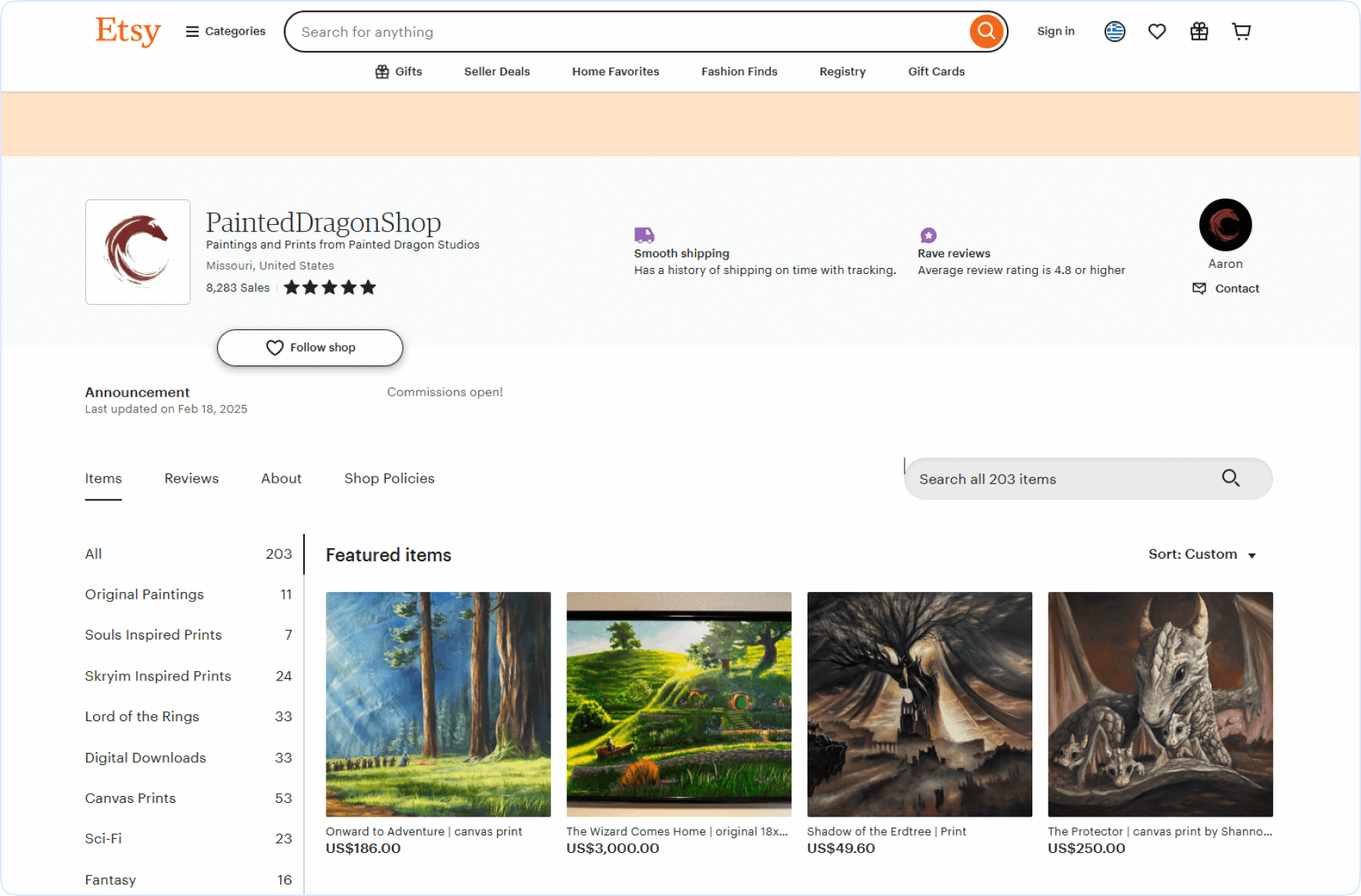
A talented artist selling his fantasy pictures on Etsy platform.
How C2C Business Model Works:
- Consumers love the C2C model as they can get high quality products or services at a cheaper price.
- In this business model online marketplace often plays a critical role as it’s hard for individuals to invest enough money in digital marketing and personal brand.
- The benefit of platforms is their payment processing functionality that minimizes risks of fraud. However, you need to be ready to pay a fee for the platform’s services.
- When it comes to services relations are often established via word of mouth and are built on trust.
- Social media offer a great way for people to engage in the C2C eCommerce business model since they enable individuals to obtain a large followership and capitalize it by selling online.
Examples of C2C eCommerce Business Model:
- eBay is an example of a classical C2C marketplace. People can find sellers from all over the world. It also helps process purchases.
- Facebook Marketplace is similar to eBay, however, it’s more tied to the location of the seller and customer.
- Craigslist is a website with classified ads, one of the oldest marketplaces there is.
Key Characteristics of C2C Business Model:
- It’s great for both occasional (e.g., your furniture as you move out or clothes that you’re tired of) and regular sales.
- It doesn’t require a lot of investment in marketing, but you really need to work on customer service and reputation.
- You do not need to invest a lot in technology.
Winday Usage:

Using Winday is easy, and it drives customer engagement & loyalty.
Gamification is a great way to create an impressive customer experience for your clients. Creating Instant games with Winday is easy as you do not need to code anything. The whole process takes less than 30 minutes. In the end, you’ll get a custom link to your game that you can share on your marketplace or social networks offering your potential customers to play and win cool prizes or discounts.
🔝 Pro Tip:
Publish your game in Winday Club where customers are looking for special offers and discounts.
4. Consumer-to-Business (C2B) Business Model
Also known as freelance, the consumer-to-business model emerged as an alternative to regular office work. Today it’s one of the most widespread types of eCommerce businesses.
Definition:
In the C2B model, consumers offer their products or services to businesses online. Usually, they connect with businesses via specialized platforms, like freelance marketplaces, or professional social networks like LinkedIn.
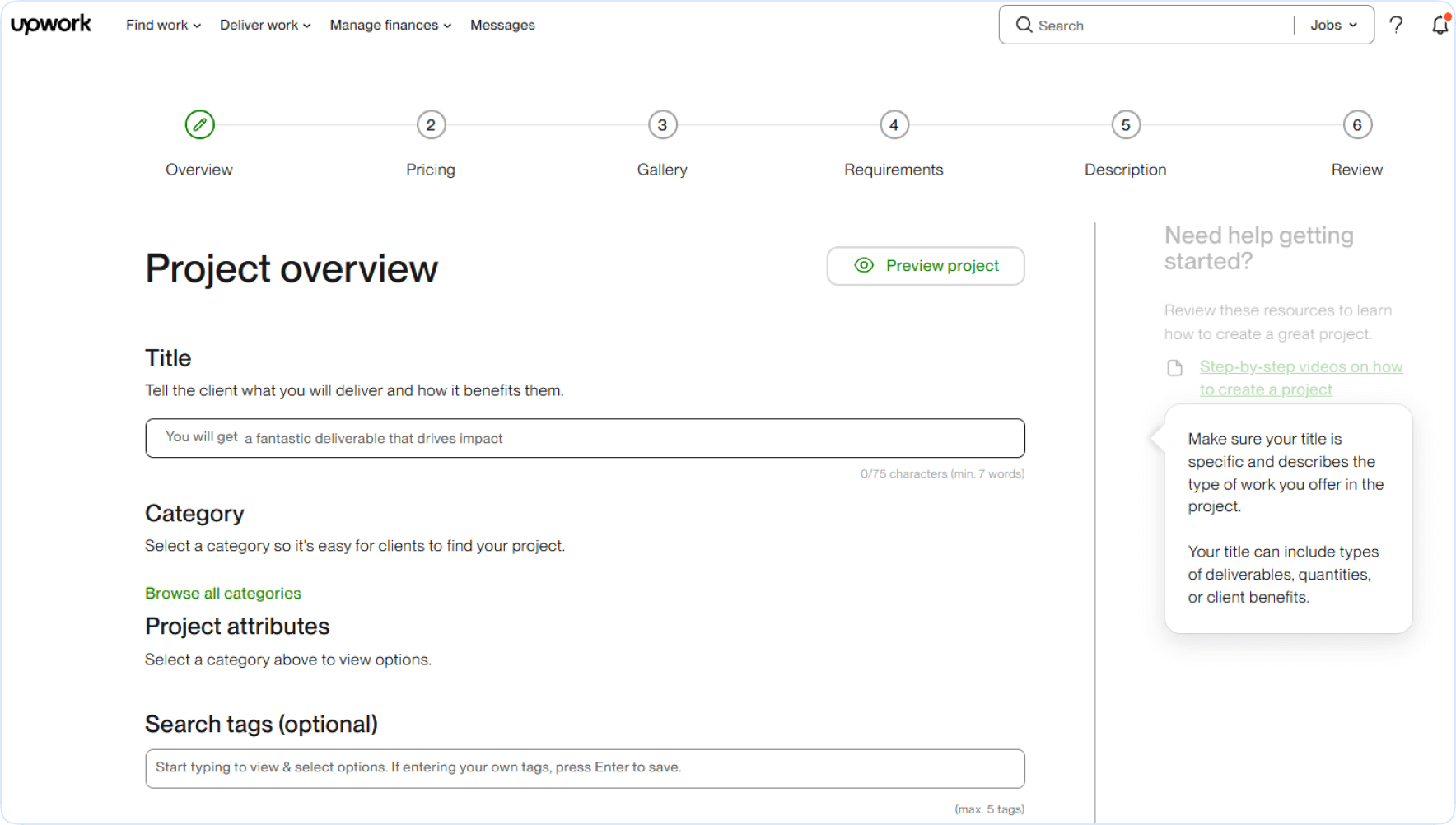
An example of Upwork functionality enabling users to promote their services.
How C2B business Model Works:
- Businesses are looking for individuals who can provide certain services on a semiregular or project basis.
- An individual can have a regular job and want a side hustle during their free time.
- Marketplaces often work with bidding systems enabling consumers and businesses to bid on the offering. They also process payments.
- Influencer marketing and affiliate marketing when individuals promote business services and products to their audience is a popular type of C2B business.
Examples of C2B eCommerce Business Model:
- Upwork & Fiverr are websites where freelancers can create accounts and connect with businesses looking for people to complete their projects.
- Shutterstock & Adobe Stock are marketplaces for photographers who want to sell their photos to companies.
Key Characteristics of C2B Business Model:
- This model is beneficial for businesses that can’t always offer full-time positions for certain work but have a skill gap that they need to close.
- It is also a great way to diversify earnings for individuals with marketable skills or influencers.
Winday Usage:

Game creation process in Winday.
Winday has shown great results in affiliate marketing with gamification techniques since it’s an efficient way to engage your audience with the brand that you promote. You can easily create a game and raffle discount codes to services or products of your sponsor. Additionally you can get listed on Winday Club to get discovered by new customers.
5. Direct-to-Consumer (DTC) Business Model
Some consider DTC as a subtype of the B2C model as there are many similarities.
Definition:
In the DTC business model, manufacturers sell directly to customers without intermediaries like retailers or marketplaces. This model works for large and popular brands that have enough resources to create online stores and get them to the top of SERP.
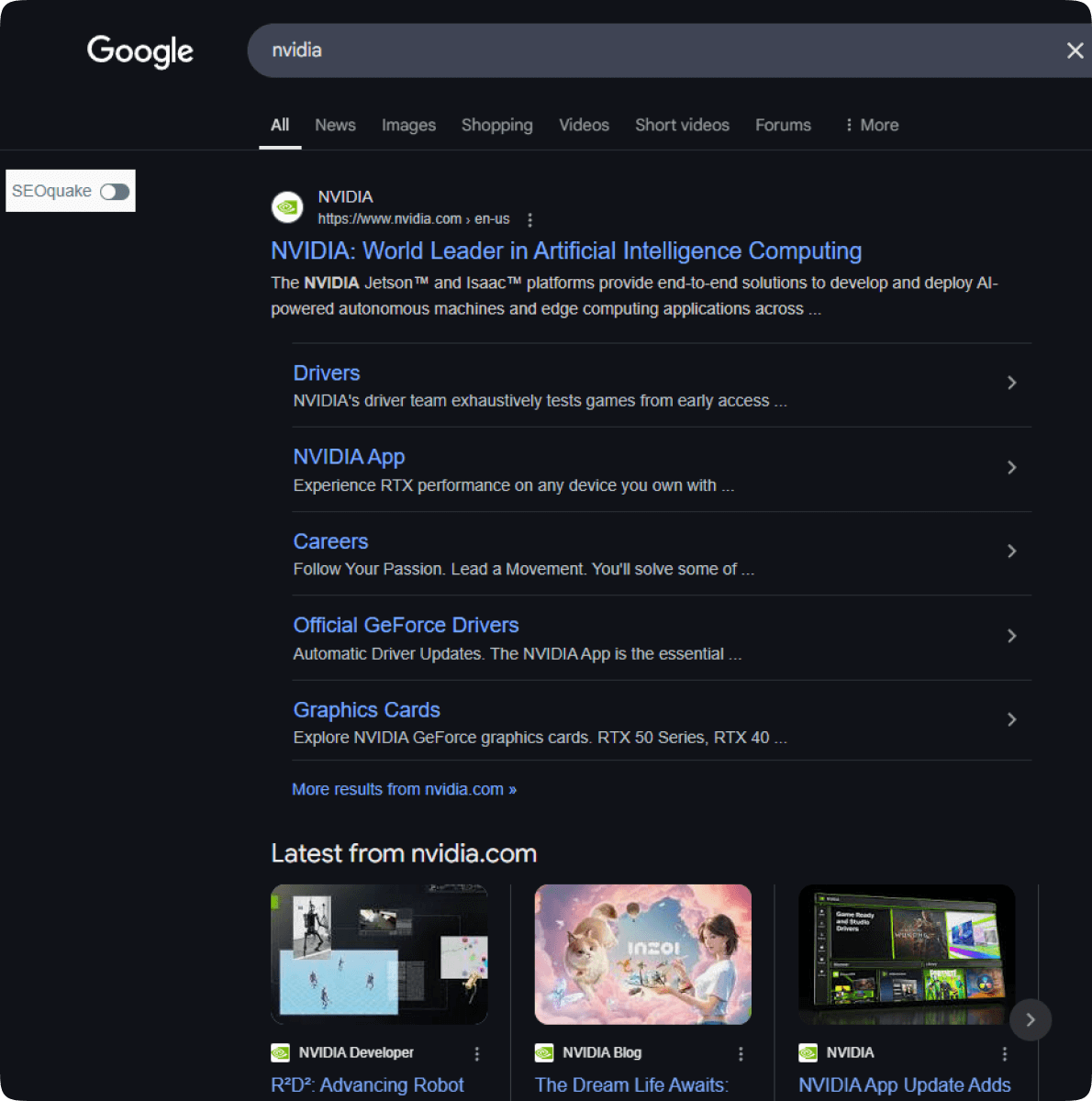
When individuals are looking for NVIDIA products, the manufacturer’s website is the first in Google.
💡 Did You Know?
NVIDIA has several business models including B2B and DTC, and also subscription-based model for their AI offerings
How DTC Business Model Works:
- Companies sell the products they manufacture to end users on their own websites or applications.
- Because no intermediaries are involved, companies can get higher profit margins. At the same time they also have more control over their brand.
- Marketing focuses on building brand reputation and customer loyalty as well as promotion of their stores on the Internet.
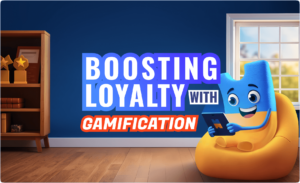
Examples of DTC eCommerce Business Model:
- Glossier is a cosmetics manufacturer that sells their products via their own online stores.
- Brandless is a brand of wellness products sold under the DTC model.
- Nike’s online store is an example of a manufacturer that sells goods via both retailers and their own online store.
Key Characteristics:
- Requires significant marketing investments, especially in building their brand.
- Can provide branded customer experience.
- Build relations with customers and heavily depend on loyalty, especially if the company doesn’t sell to retailers.
Winday Usage:
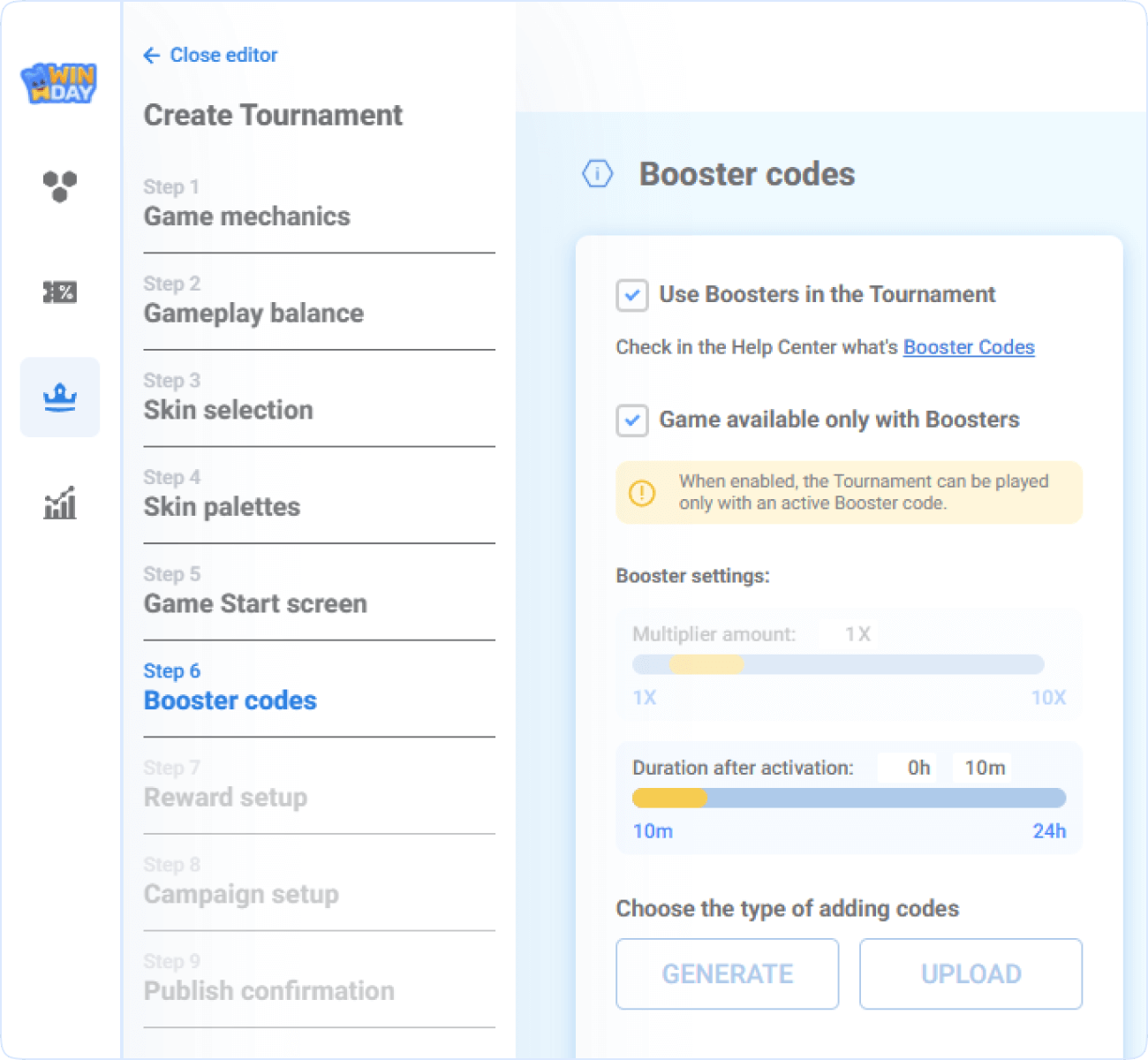
Winday functionality to create an exclusive tournament that can only be accessed with special codes.
DTC companies can use Winday to provide a branded customer experience and improve loyalty. Here are two tips how to make the most of Winday platform:
- Create a game using Winday and publish it on your website. Grant discounts to your products to customers who win instant games or take winning places at game tournaments.
- Create an exclusive tournament with Winday and offer customers at brick-and-mortar stores access codes to access these tournaments to win special prizes.
6. Subscription-Based Business Model
Definition:
Working both as B2B and B2C, a subscription based business model offers end customers or businesses pay for the subscription to access a certain product, service or content.
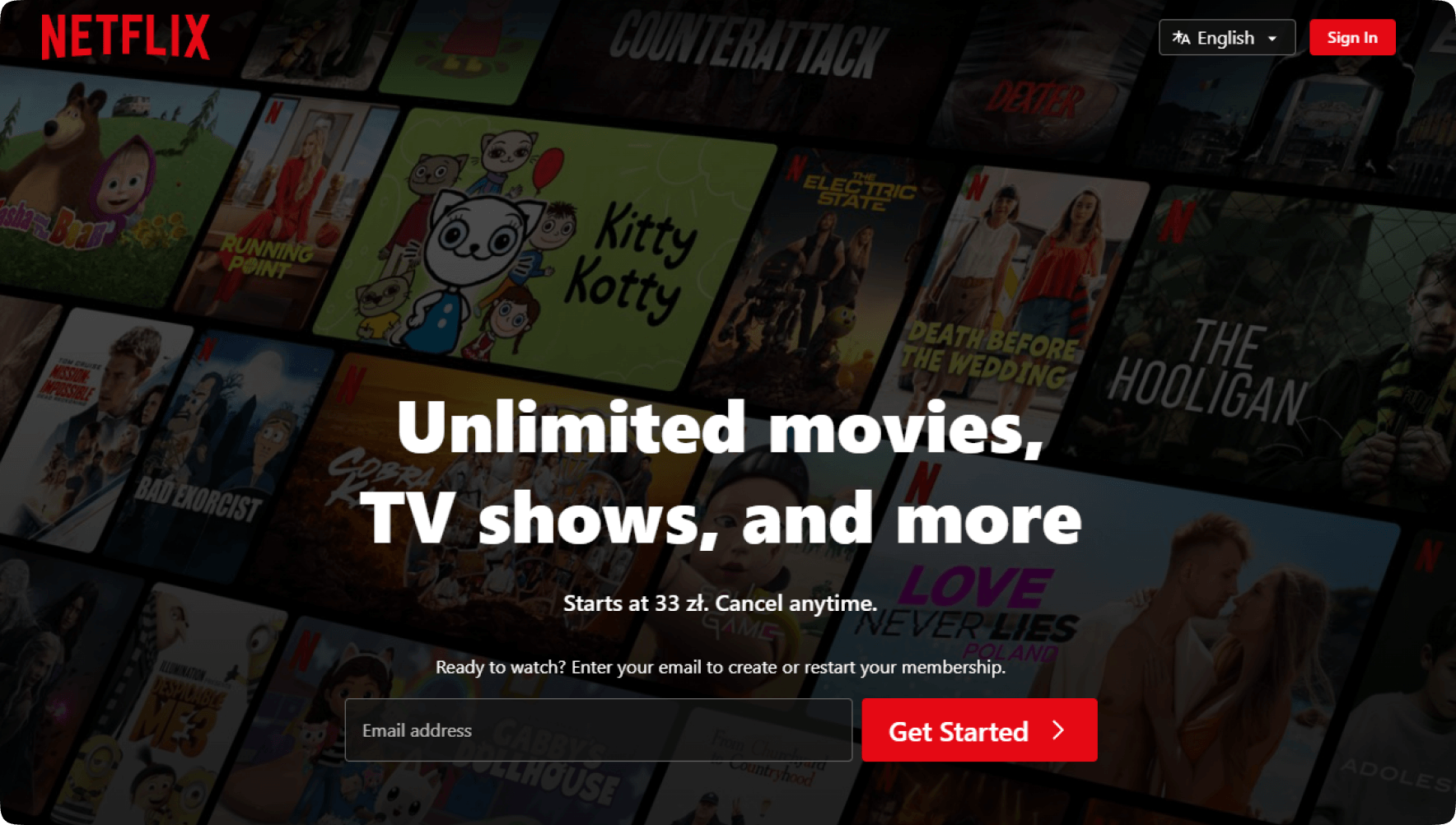
Netflix is an example of subscription-based model when customers pay for access to exclusive content.
How Subscription Service Business Model Works:
- This model works best for digital services like streaming platforms, Software as a Service, AI as a Service, Platform as a Service, Infrastructure as a Service.
- Customers or businesses pay to the providers monthly, quarterly or annually to retain access to the product or service.
Examples Subscription-Based eCommerce Business Model:
- Netflix is a platform that grants access to movies, TV shows and games.
- Google Workspace is a SaaS offering collaboration and productivity tools for Business like email, text editor, calendar, spreadsheets, etc.
- Winday is a marketing gamification SaaS platform that offers businesses and individuals an opportunity to achieve their marketing goals by creating zero-code games.
Key Characteristics of subscription based business model:
- Instead of paying once for a digital product and owning it, customers pay for the right to use it.
- Customers think that they pay less compared to the full price of the product but in reality they pay more as they can stay for years.
- High customer retention creates high CLV, especially for products that are prone to vendor lock-in like backups.
- Companies need to invest significant resources into nurturing customer retention by providing unique or best in class features or content.
Winday Usage:
Winday gamification platform can help businesses with a subscription-based model to attract more customers via unique gaming experience. Create a marketing game in just 30 minutes and embed it on your application (or website), offering your customers an opportunity to win a discount to one month of subscription. This method has proven very efficient for SaaS who have freemium access to some content / functionality, converting users to paying customers.
7. Dropshipping Business Model
One of great eCommerce business models for businesses that want to operate almost entirely online.
Definition:
In the business model of dropshipping, a company acts as an intermediary between the supplier and the end consumer, but doesn’t own warehouses or stores products.
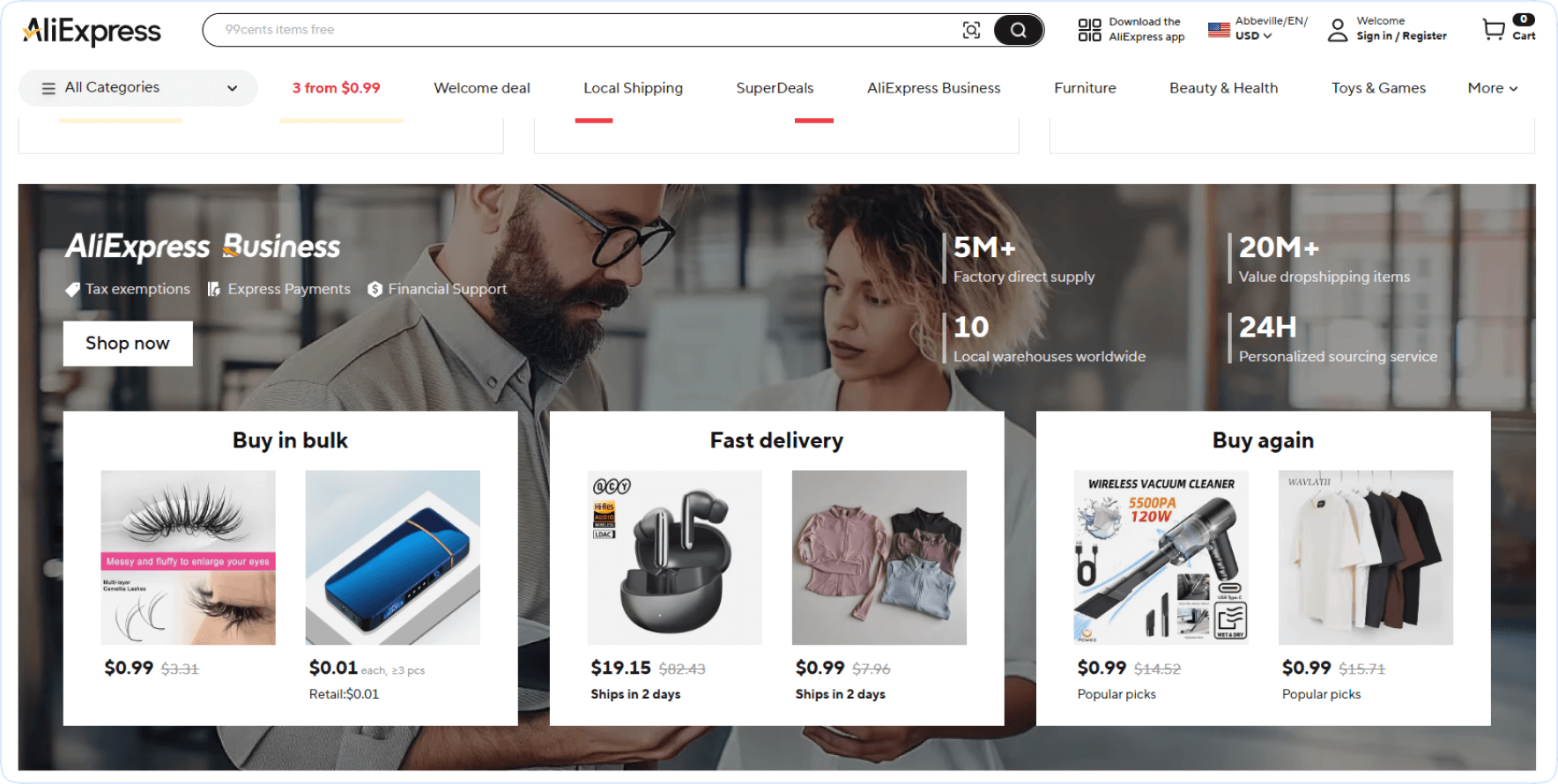
AliExpress is an example of dropshipping.
How Business Model of Dropshipping Works:
- Company creates an online store where they list products they picked from suppliers.
- They establish pricing for the listed products.
- Customer picks a product and pays the company.
- Company purchases the product from the supplier and orders shipment of the product to the customer location.
- Company earns by taking the difference between the price they paid the supplier and the price they got from the customer.
Examples of Dropshipping eCommerce Business Model: AliExpress dropshipping – many goods on AliExpress are sold via dropshipping.
Key Characteristics of dropshipping business model:
- Company can handpick the suppliers it wants to work with.
- It can better control the pricing depending on market fluctuations.
Winday Usage:
Similar to other types of business models in e-commerce drop-shipping companies suffer from cart abandonment and low conversions. Gamified experiences can help differentiate the business and motivate the customers to complete a purchase as they don’t want to lose the discount they won in a game.
8. White Label & Private Label
Two distinctive types of business models in e-commerce that share the same feature: business resell products manufactured by another company under their brands.

Pizza manufacturer for Private Label.
Definition:
- White Label: Manufacturers sell generic products to various retailers. Some retailers chose to rebrand them as their own.
- Private Label: Manufacturers produce specific products for a brand that are unique and aren’t sold elsewhere.
Examples:
- Reusable water bottles are often purchased by companies as white label and then rebranded.
- Cosmetics brands – order manufacturers specific products and then sell them as private labels.
Key Characteristics: Great for businesses that have no resources to invest in creating and running manufacturing and want to focus on branding and building a customer base.
Winday Usage:
Winday games can be used to create exclusive customer experience, increase conversions and drive brand engagement.
🔝 Pro Tip:
Create a set of products (e.g., testers for your new line of lipsticks). Offer your website visitors to participate in a tournament against other players with an opportunity to win the set. Tournament can be created and launched in less than 40 minutes. You can place it on your website, marketplace, or share it via link or QR Code.
9. Wholesale Distribution
This is a subtype of B2B business that is focused on mass buying of products. Sometimes it is also used for B2C buying in bulk.
Definition:
In the wholesale business model, distributors and manufacturers sell products to retailers in bulk. They can also sell parts, equipment, or raw materials for other manufacturers that use them in their production.

Accio B2B wholesale marketplace.
How Wholesale Distribution Business Model Works:
- Companies find suppliers at B2B wholesale marketplace.
- In another scenario, retailers find wholesale businesses online.
- Often wholesale distributors and manufacturers actively contact retailers through outbound outreach (email or LinkedIn).
- In both cases, they purchase goods at a discounted price and resell them at a higher price.
- Wholesale marketplaces usually speed up the process of purchasing for both sellers and buyers.
- However, in other scenarios, sales cycles can be long and engage multiple decision makers.
- The key factors that impact a buyer’s decision are prices and quality.
Examples of Wholesale eCommerce Business Model:
- Accio is an example of a B2B wholesale marketplace.
- Costco Business is a company that sells products in bulk and offers high discounts.
Key Characteristics of Wholesale Business Model:
- Margins are lower due to discounts on products.
- Profits are made due to high volumes.
- Companies don’t need to make significant investment in marketing or brand and focus on quality of products.
- Outside marketplaces, participants of wholesale purchase often conclude a long-term contract with multiple recurring purchases.
- This model requires significant investments.
Winday Usage:
Create a branded tournament with a leaderboard to attract retailers and offer special discounts to winners. It works best on marketplaces where you can embed your game directly, and where sales cycles are shorter. Games can attract the attention of potential buyers as a novelty. It can also help them by making a hard decision-making process fun and entertaining.
10. Print-on-Demand (POD) Business Model
Print-on-demand model is relatively new and is tied to buyers’ need for unique items.
Definition:
Print-on-demand business model is a type of DTC where manufacturers only produce products when they receive the order. They often augment products by covering them with unique patterns or prints (hence the name of the model).
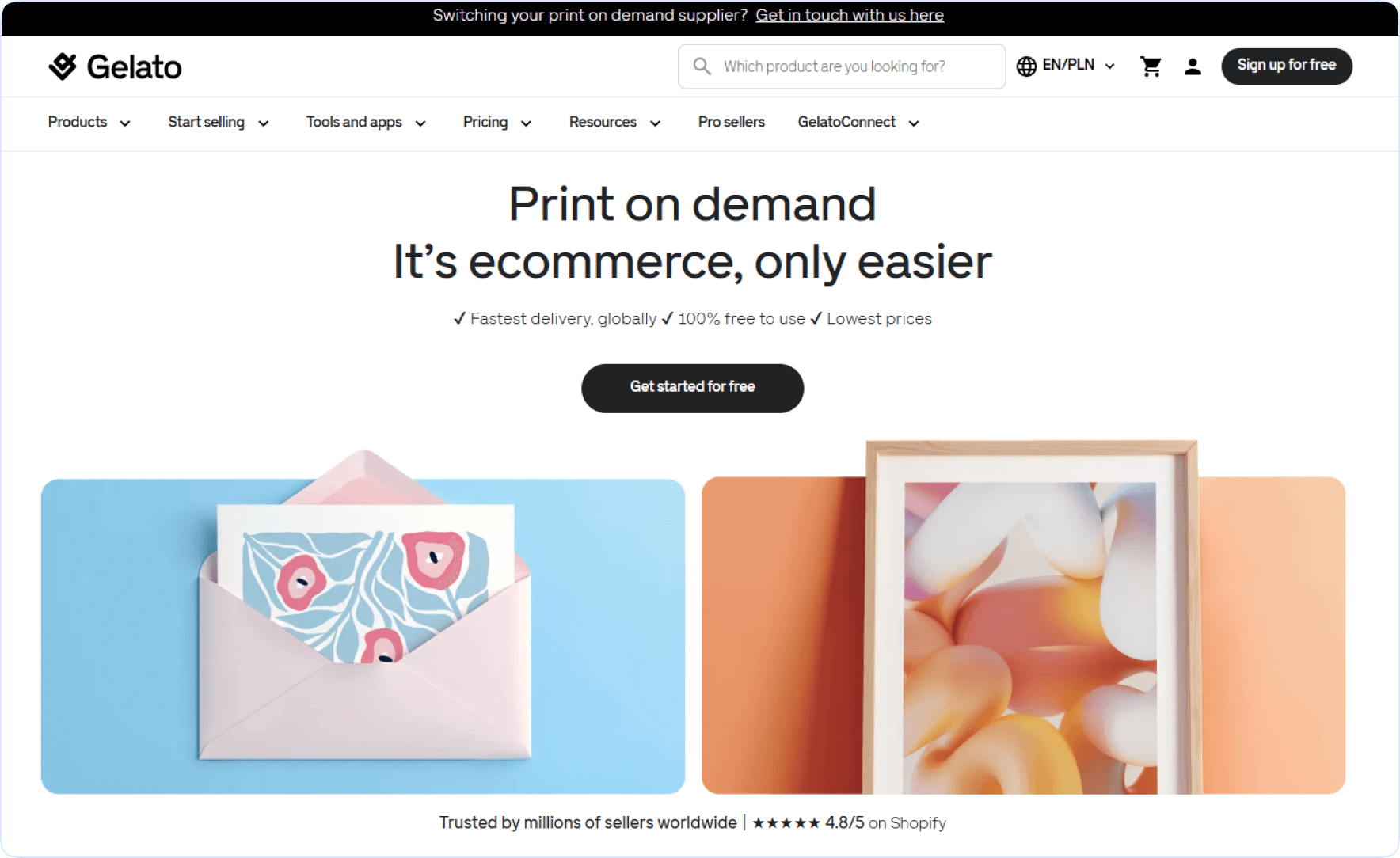
An example of print-on-demand marketplace.
How POD Business Model Works:
- A seller has a small manufacturer that can produce new items or a printing equipment to alter ready-made products.
- A seller creates an online store or an account on the POD marketplace.
- They offer customization of the articles they sell or creating new items (often in unique colors or prints).
- As a result their customers can obtain exclusive items.
- It works well for people who have good aesthetic taste or some wit (in case it’s a slogan) and can create designs that match the product.
- Alternatively, they can buy new designs from stock images.
Examples of POD eCommerce Business Model: Printful, Redbubble, Teespring are examples of companies that offer POD clothes and accessories.
Key Characteristics of the print-on-demand business model:
- It decreases the costs for storage and reduces the risk of overstock.
- Often this model is used for easily customizable items like closing or cups.
- Selling process is slow as it requires time for manufacturing.
- Marketing focuses on attracting clients who want to stand out.
- Efficient marketing practices include: influenced marketing, SMM, website + SEO.
- You need to invest a lot in design.
Winday Usage:
Create marketing instant game offering your potential customers to play and win a discount on your products or an additional customized product as a gift. With Winday, you don’t need to code or understand how gamification mechanics work. You can focus on attaining your marketing goals.
🔝 Pro Tip:
Use Winday games in affiliate marketing. Your Publisher can post a link (or QR code) to your game on their digital assets. Learn more about how gamification in Affiliate Marketing works
11. Marketplace Model
This model is similar to dropshipping, but there are several differences.

Australians selling toy spiders on eBay for fun.
Definition:
In the marketplace business model, a company acts as an intermediary between suppliers and end consumers without storing goods.
How Online Marketplace Business Model Works:
- Company creates a website.
- Suppliers create accounts on the marketplace.
- Customers find the products or services they need.
- Buyers pay for products directly to the supplier.
- Marketplace gets a commission for each transaction.
Examples Marketplace eCommerce Business Model: Amazon Marketplace is a great example of a classical online marketplace.
Key Characteristics of the Marketplace business model:
- Marketplace has much lower control over prices and marketed products or services compared to dropshipping.
- You need to make a substantial investment in digital marketing to get your marketplace to the top of SERP. You will have to compete with other marketplaces and online stores.
- High turnover of deals.
- As a marketplace owner you do not need to be heavily involved in each purchase, as you don’t buy the goods from the manufacturer.
- Instead you need to focus on making your marketplace easy and safe to use. So, you’ll need to invest a lot in product development.
Winday Usage:
Place Winday widget on your Marketplace page to motivate your customers to get discounts for your goods and enjoy higher customer conversion and retention. You can try both instant marketing games and branded tournaments and see what works best for your TA.
12. Flash Sales & Group Buying
These are two distinctive types of B2C model. Although in Group buying people are encouraged to engage in purchasing multiple similar products and services, it is still considered a B2C as the end consumers are on the receiving part of the deal.
Definition:
One of the lesser-known online business models, flash sales and group buying models offer customers significant discounts on products or services. Flash sales offer discounts for a limited amount of time. Group buying grants discounts on the prerequisite of a bulk purchase from a group of customers. Usually group buying encourages consumers to ask their family and friends to participate in the purchase.
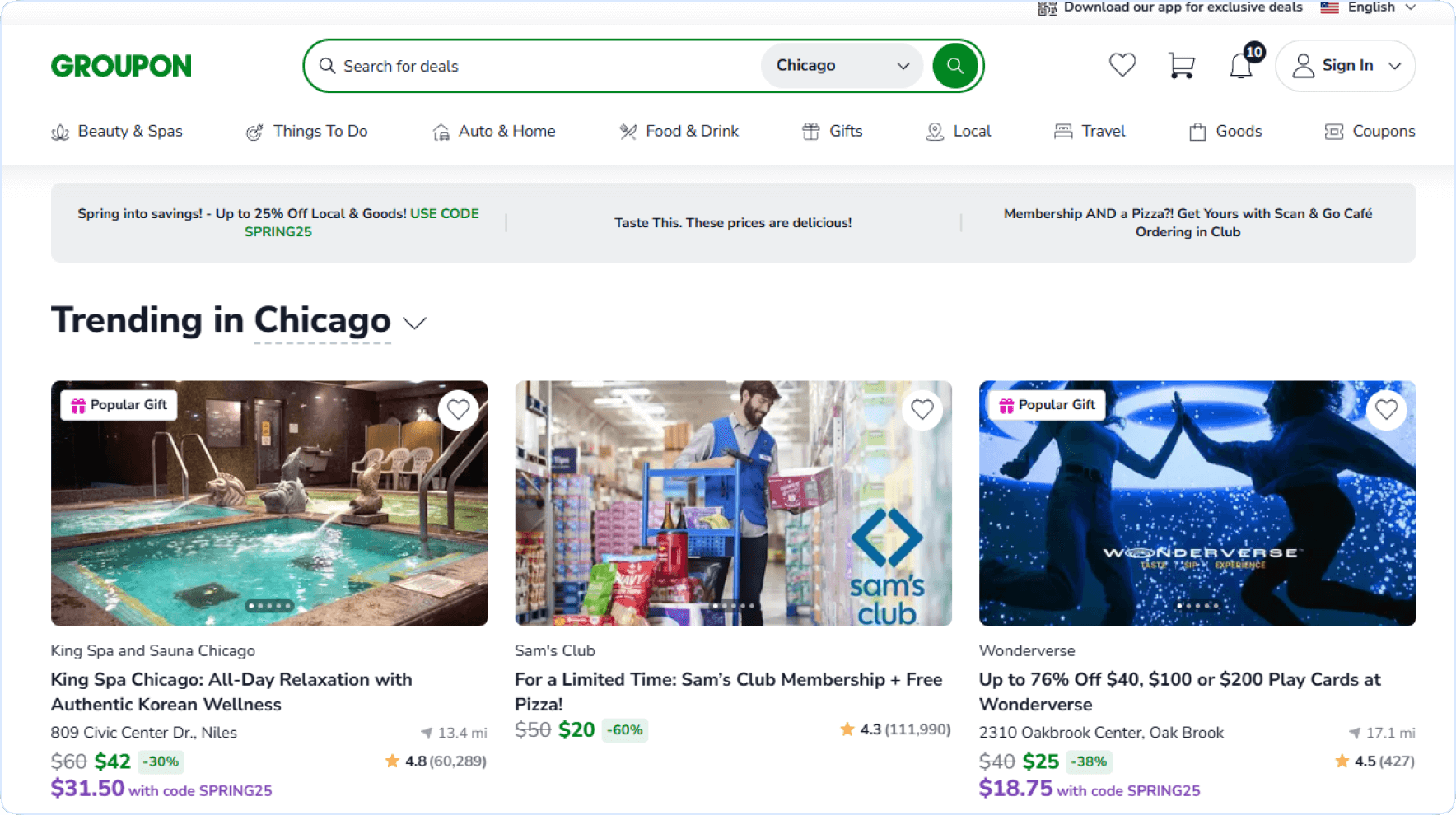
Group buying example on Groupon.
How Flash Sales Business Model Works:
- A seller has multiple items (usually of low quality or overstock) they wish to quickly sell.
- They create a limited-time offer on their website or in ads.
- The time limitation creates a sense of urgency and plays with a fear to lose the lucrative deal. Usually time is limited to a couple of hours, up to one day.
- People buy on a spur of emotion without rational thinking just because the price is so low.
- Often, multiple different items are offered at a discount rate which results in quite a big cart.
How Group Buying Business Model Works:
- Group buying usually takes place on special marketplaces and much more rarely on the website of the seller.
- Customers can only get a discount if there’s a certain amount of buyers purchasing with them.
- Since group buying has been around for some time, many people became regular clients and they specifically check on the marketplaces (with a readily available group of people ready to buy).
Examples of Group Buying and Flash Sales Online Business Models:
- Groupon – an example of a group buying marketplace.
- Wish – an example of a dropshipping model that utilizes flash sales to buy goods that are often reported by customers online to be of low quality.
Key Characteristics:
- Faster sales and higher conversions are boosted by the fear of missing on a good deal.
- Flash sales heavily rely on impulse buying.
- Group buying uses the customer’s network to sell products.
- Some businesses use both models to sell overstock.
- Flash sales work best with push notifications.
- Personalization can help you to boost conversion for both group buying and flash sales by offering people deals on the products they are interested in.
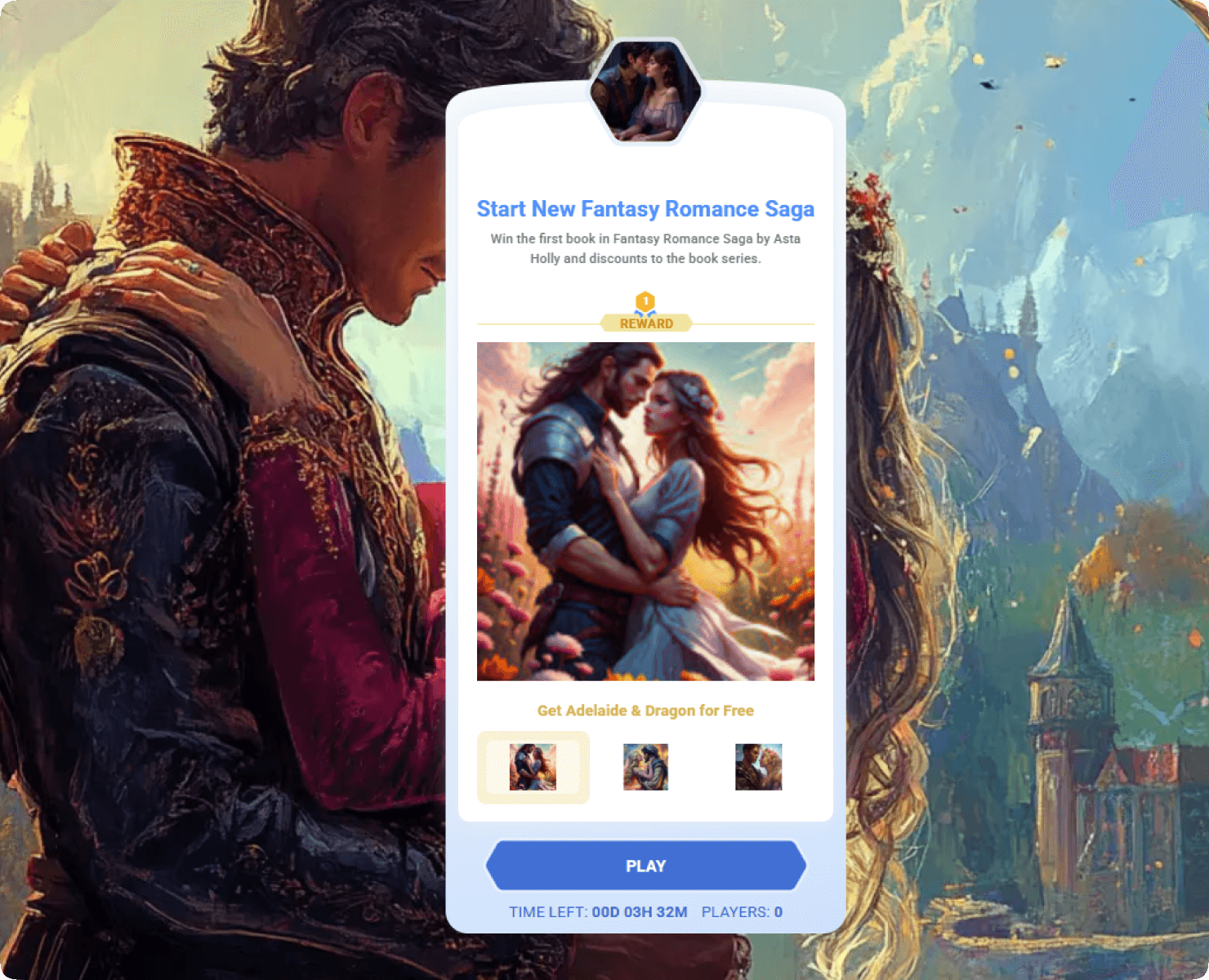
An example of tournament created with Winday.
Winday Usage:
Gamification is often used in Flash Sales to boost the sense of winning a great deal. Use Winday to create an instant game and place it on your marketplace offering your consumers to win a big discount. Create a tournament for group sales and encourage customers to invite friends and participate in the tournament to win special prizes.
13. Business-to-Consumer-to-Business (B2C2B) Business Model
While it sounds unusual, it’s one of the popular types of ecommerce businesses. Many people have unknowingly participated in it. Furthermore, many businesses benefit from it even though they do not fully strategize to make it their customer acquisition strategy.

Grammarly has been actively using a B2C2B model for a long time.
Definition:
B2C2B is a business model when products are sold to both end customers and businesses. In a more narrow meaning, B2C2B refers to the practice when a product or service is initially sold to a customer who then “sells” it on your behalf to their business.
How B2C2B Business Model Works:
- A person uses your product in their work on a regular basis. They like it a lot. They know all the ins and outs of how to use it. And they are very accustomed to it.
- They find a new job, but the new company doesn’t use your tool and the person doesn’t like the toolkit the business has.
- As they continue working they offer management to purchase your solution for their business.
- Your business doesn’t need to invest time and money to persuade another business, as your end consumer will “do the talking for you”.
Examples of B2C2B eCommerce Business Model: Grammarly is a popular example of the B2C2B model as well as many marketing tools.
Key Characteristics:
- Can be an “additional” model that complements your main one B2B or B2C
- You can invest less money on the outreach to businesses
- As your “champions” transfer from one job to another, you earn more new businesses.
Winday Usage:
Converting consumers is easier than converting businesses. Create instant games or tournaments using the Winday Marketing Gamification platform to boost your conversions and then enjoy your champion selling your product or service to their employer.
Integrating Winday into Your Business Model
Winday Gamification Platform works well with many online business models especially those that work with end consumers. For the longest time, gamification was available only to big brands that can invest hundreds of thousands of dollars and upward a year in creating a single game. With Winday, gamification became available for SMBs who do not have necessary resources and can’t afford hiring an inhouse team or game development outsourcing company.
Our games are readily available. All you need to do is plan a campaign and the best way to use the game to attract, engage, convert, or retain your customers.

Winday Dashboard.
What Benefits of Gamification Winday Provides:
- Ability to create a marketing game within 30 minutes.
- Any marketer can create a game, no coding skills are necessary.
- Publish up to 10 games simultaneously for different products.
- Choose from 5 game mechanics that can be configured based on your marketing goals and TA specifics.
- Utilize tournament functionality to hook your consumers and nurture retention.
- Ability to customize how your game looks to align it with your brand.
- Use smart analytics to track campaign performance and boost the efficiency of your marketing gamification.
- Integrate Winday with other marketing tools to get better results.
- Share your game across your digital assets using links, QR code, marketplace widget, or website embedding.
- Generate discount codes using Winday.
- The subscription-based model of Winday enables you to make small investments compared to custom game design and check if gamification works for your business and TA.
- Stand out on tight markets with games and make the buying process fun for your customers.
Boost the performance of your e-Commerce business
Create your First Game
Create interactive branded games in minutes without coding. Perfect for both online and offline merchants.
start your free planRate this article
Keep Learning
Custom Marketing Game Development vs Using Winday: Budget and Timeframes
Are you interested to know how marketing games are made and what’s the best way to build your very own game? Check out our guide for insights on game dev roadmap, prices & timeframe.
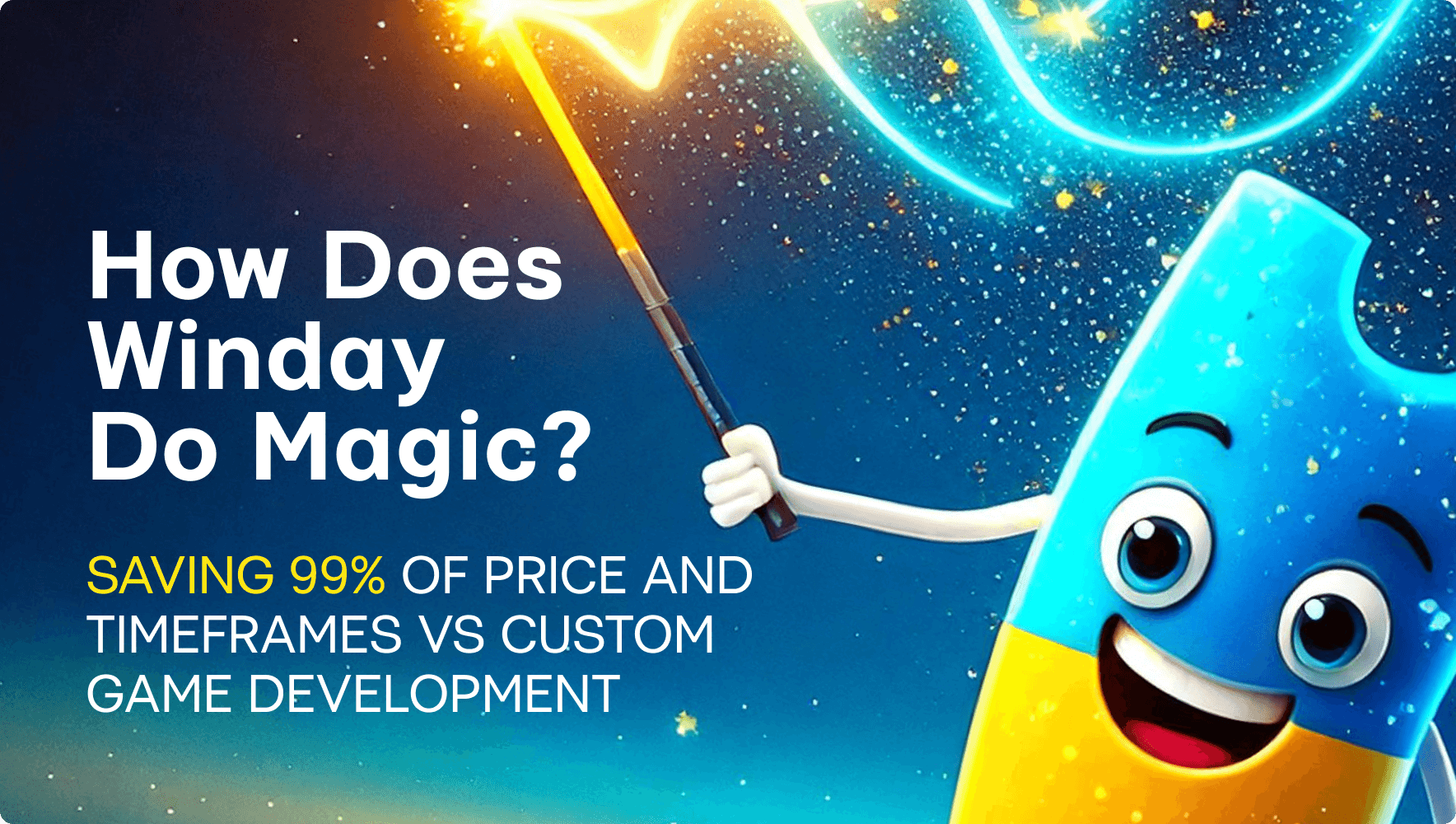
MarTech Tool Stack to Promote Your Business
Check out an overview of marketing tools available on the market today and learn how to build MarTech Stack that meets your unique business needs.
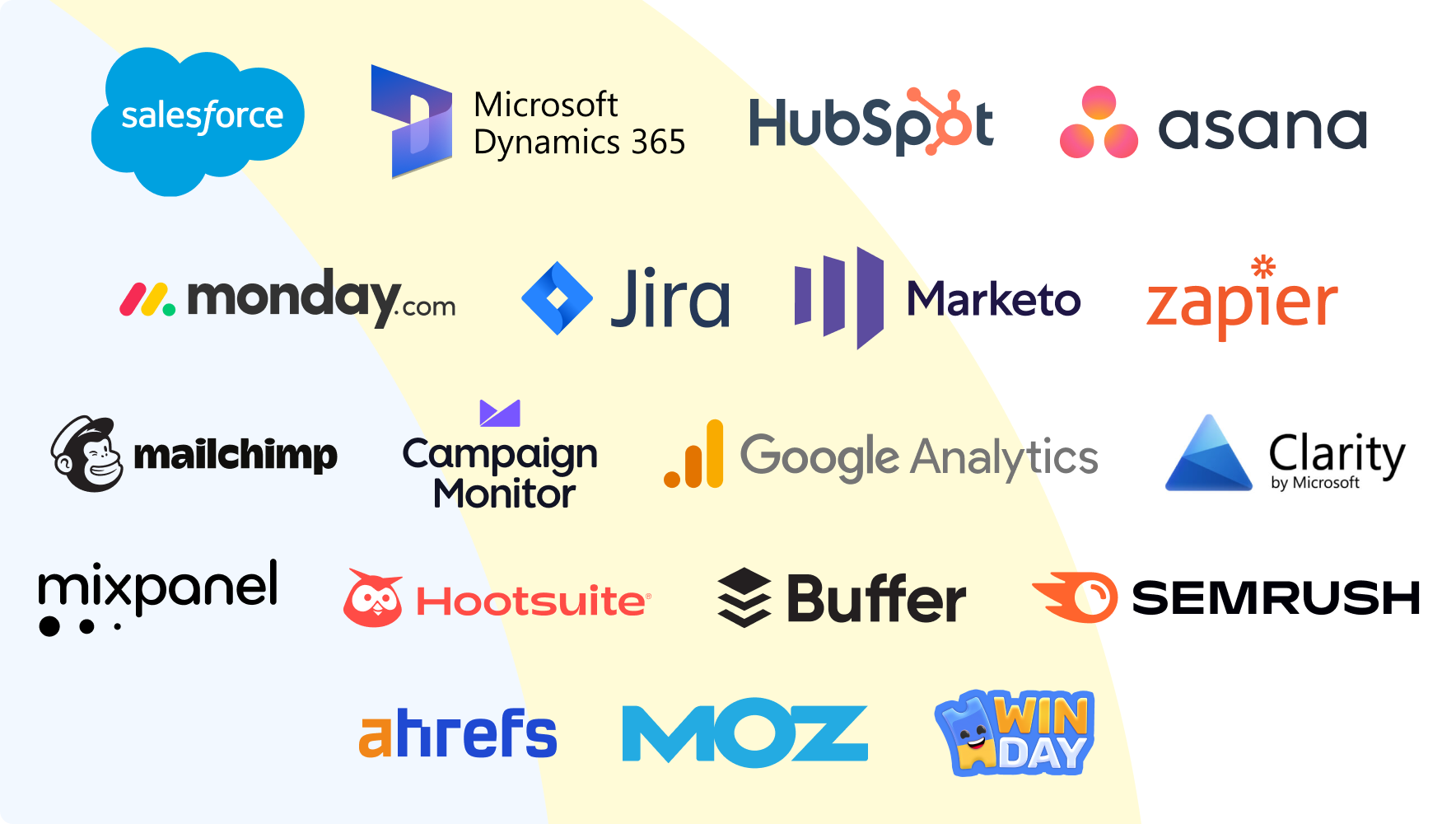
Marketing Calendar 2025 - Gamified Marketing Campaign Plan
Looking for ways to add gamification on your marketing calendar 2025? Check out our guide to gamified marketing campaigns for the upcoming year.


